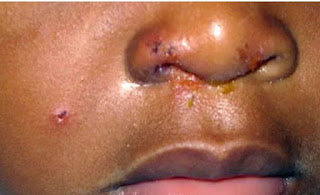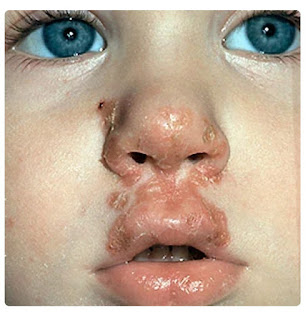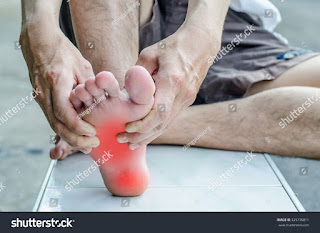Impetigo
Written by Timothy Okooboh

In my previous post, I explained several skin lesions such as blisters, bullae, crust etc. A sound knowledge of skin lesions is fundamental to understanding various skin infections including impetigo. You can take a few minutes to read my post on skin lesions here→https://bit.ly/2OXo18Z
What is impetigo (also known as School Sores)

In my previous post, I explained several skin lesions such as blisters, bullae, crust etc. A sound knowledge of skin lesions is fundamental to understanding various skin infections including impetigo. You can take a few minutes to read my post on skin lesions here→https://bit.ly/2OXo18Z
What is impetigo (also known as School Sores)
- It is a highly contagious bacteria skin infection that affects the epidermis (the outer layer of the skin).
- Because it is a skin infection of the epidermis, it is therefore a superficial skin infection.
- It is mainly characterized by sores, blisters or bullae on the epidermis of the skin, which later release pus that form yellowish or sometimes reddish-brown crusts on the skin.
- Therefore, in summary, impetigo is an epidermal bacterial blistering skin infection.
- Young children especially between the ages of 2 to 6yrs. Impetigo affects adults and older children too but it is more common among younger children. Why do you think this is so? Well, remember that impetigo is highly contagious, hence it can easily spread by direct skin to skin contact. Skin to skin contact is very common among younger children as they often play together.
- Poor hygiene
- Overcrowding
Causes of impetigo
Impetigo is a bacteria skin infection. Impetigo is caused by Staphylococcus aureus or Beta-hemolytic streptococci. Some cases of impetigo are caused by both of these bacteria at the same time. In rare cases, a type of bacteria called Pseudomonas aeruginosa may be the cause of impetigo.
Types of Impetigo
There are two types of impetigo depending on the presence or absence of bullae on the skin. Bullae are large blisters on the skin, usually more than 1cm in diameter. (For more information about various kind of skin lesions, see here →https://bit.ly/2OXo18Z
Bullous impetigo is characterized by several bulla on the surface of the skin. After sometime, these bullae can burst and release pus which will form crusts over the surface of the affected skin as seen in the image above. Bullous impetigo can also cause irritation on the skin because the large blisters can make contact with sensory nerves beneath the epidermis. In babies, bullous impetigo usually occur in the buttocks.
NB: only Staphylococcus aureus is known to cause bullous impetigo
2. Non-bullous impetigo
Non-bullous impetigo is more common than bullous impetigo. This type of impetigo does not present with bullae. However, there are sores and/or blisters on the skin which quickly burst to form crusts. The blisters are not usually painful but can be itchy.
Therefore, as expected from the explanations above, the main symptoms of impetigo are sores, blisters or bullae, honeycomb-yellowish or reddish crusts and itching on the affected areas of the skin. In addition to the various skin lesions, there may also be fever.
Common areas of the skin infected by impetigo
Common areas of the skin infected by impetigo are:
1. The face; usually around the nose and mouth.
2. The hands or arms.
3. The Buttocks
4. Back of the neck
5. The legs.
Complications of Impetigo
Are you surprised that a superficial bacterial skin infection like impetigo can cause complications?
Well, yes it can! Untreated or poorly treated impetigo could lead to complications.
For instance, Staphylococcus aureus can produce certain enzymes called exfoliative enzymes which enables it to penetrate deeper into the skin. These can lead to a skin condition called cellulitis ( an infection of the dermis and subcutaneous tissues). If the bacteria penetrates deeper into the skin, it can get to the blood vessels and cause sepsis or bacteremia. These are serious and life threatening conditions.
Beta-hemolytic streptococci causing impetigo can on rare occasions cause glomerulonephritis, an inflammation of the glomerulus of the kidneys.
How to prevent spread of the disease
Impetigo is a highly contagious skin infection. However, spread from person to person and from the affected area to other parts of the body can be prevented by:
Treatment of Impetigo
Impetigo can be self resolving. That is, the symptoms may resolve on their own after sometime. However, it is advisable to treat it once it occurs inorder to prevent spread, complications and to promote faster healing. It is treated with topical antibiotics and in severe cases, oral antibiotics can be used.
Please note: We live in an era of widespread antibiotic resistance. Therefore, we @Health Hub promote the use of appropriate antimicrobial sensitivity tests (as much as possible) before recommending antibiotics.
Topical antibiotics such as mupirocin (Bactroban) and retapamulin (Altargo) can be used. Oral antibiotics such as flucloxacillin, cephalexin, cefpodoxime, can be used, depending on antibiotic sensitivity tests.
Topical and oral antibiotics must be used throughout the prescribed duration of treatment even if the symptoms resolve before completing the medication.
Home remedies
Certain natural remedies have been shown to help relieve the symptoms of impetigo. They include:
Bullous impetigo is characterized by several bulla on the surface of the skin. After sometime, these bullae can burst and release pus which will form crusts over the surface of the affected skin as seen in the image above. Bullous impetigo can also cause irritation on the skin because the large blisters can make contact with sensory nerves beneath the epidermis. In babies, bullous impetigo usually occur in the buttocks.
NB: only Staphylococcus aureus is known to cause bullous impetigo
2. Non-bullous impetigo
Non-bullous impetigo is more common than bullous impetigo. This type of impetigo does not present with bullae. However, there are sores and/or blisters on the skin which quickly burst to form crusts. The blisters are not usually painful but can be itchy.
Therefore, as expected from the explanations above, the main symptoms of impetigo are sores, blisters or bullae, honeycomb-yellowish or reddish crusts and itching on the affected areas of the skin. In addition to the various skin lesions, there may also be fever.
Common areas of the skin infected by impetigo
Common areas of the skin infected by impetigo are:
1. The face; usually around the nose and mouth.
2. The hands or arms.
3. The Buttocks
4. Back of the neck
5. The legs.
Complications of Impetigo
Are you surprised that a superficial bacterial skin infection like impetigo can cause complications?
Well, yes it can! Untreated or poorly treated impetigo could lead to complications.
For instance, Staphylococcus aureus can produce certain enzymes called exfoliative enzymes which enables it to penetrate deeper into the skin. These can lead to a skin condition called cellulitis ( an infection of the dermis and subcutaneous tissues). If the bacteria penetrates deeper into the skin, it can get to the blood vessels and cause sepsis or bacteremia. These are serious and life threatening conditions.
Beta-hemolytic streptococci causing impetigo can on rare occasions cause glomerulonephritis, an inflammation of the glomerulus of the kidneys.
How to prevent spread of the disease
Impetigo is a highly contagious skin infection. However, spread from person to person and from the affected area to other parts of the body can be prevented by:
- Proper washing of hands.
- Avoid touching the sores and blisters even though they can be itchy.
- Clothes and towels should be sterilized in hot water.
- Avoid sharing of clothes, towels and under garments.
- Keep infected children at home, away from school, till the infection resolves.
Treatment of Impetigo
Impetigo can be self resolving. That is, the symptoms may resolve on their own after sometime. However, it is advisable to treat it once it occurs inorder to prevent spread, complications and to promote faster healing. It is treated with topical antibiotics and in severe cases, oral antibiotics can be used.
Please note: We live in an era of widespread antibiotic resistance. Therefore, we @Health Hub promote the use of appropriate antimicrobial sensitivity tests (as much as possible) before recommending antibiotics.
Topical antibiotics such as mupirocin (Bactroban) and retapamulin (Altargo) can be used. Oral antibiotics such as flucloxacillin, cephalexin, cefpodoxime, can be used, depending on antibiotic sensitivity tests.
Topical and oral antibiotics must be used throughout the prescribed duration of treatment even if the symptoms resolve before completing the medication.
Home remedies
Certain natural remedies have been shown to help relieve the symptoms of impetigo. They include:
- Removing crusted areas with vinegar solution. Add 5 to 6 drops of vinegar in a cup of warm water. Soak affected skin areas in the solution for 20 to 30 mins. Then remove the now softened crusts gently and rinse off with cool water.
- Aloe vera gel can be applied on the affected area.
- Grapefruit extract diluted with water can be dabbed on the skin with cotton wool.
These natural home remedies have not been scientifically proven. But there are reports about their ability to help relieve the symptoms especially because of their antimicrobial properties.
Kindly leave your comments or questions below.
Help share if you found this article helpful.
Up next: Cellulitis
Kindly leave your comments or questions below.
Help share if you found this article helpful.
Up next: Cellulitis







Thank you so much,
ReplyDeleteQuite educative.
You are welcome Dr. Chuka
DeleteThanks
ReplyDeleteYou are welcome
DeleteThis is great.
ReplyDeleteEnlightening!
ReplyDeleteThanks Bro for sharing such informative and beautiful article onImpetigo
ReplyDeletehttps://crazybulkstore.blogspot.com/2020/10/guide-for-beginners-to-get-success-in.html
Thanks Bro for sharing such informative and beautiful article on Impetigo
ReplyDeletehttps://muscleplusfactsorg.blogspot.com/2020/10/try-not-to-be-anxious-afraid-or-sad.html
Wonderfull articles for Help diet.
ReplyDeletehttps://dermavixskin.com/is-fat-free-diet-best-for-health/
Amazing Health tips for Healthy Body.
ReplyDeletehttps://biojoltrevi.blogspot.com/p/bio-jolt.html